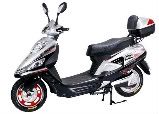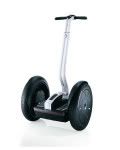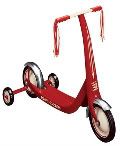 Make Way - Make Way!
Make Way - Make Way!
Wow those electric bikes are neat! A fairly inexpensive one might cost $750 (CDN) and it would have a range of 30-40 km carrying around 91 kg at up to 25 km/h. (200lbs at 16 mph). You can charge it in 6-8 hours (6-8 hours ;-) ) for pennies and you can pedal to assist the range and enhance the performance. I was taking specs off of one sold by Daymak.  It is their "Paris" model (on the left). That is a very bicycle looking electric bike. You could possibly put its 40-43 kg weight on one of our transit bus bike racks and take it with you on board public transit to extend its useful range - especially useful if there is a freeway bridge between you and destination even if it is well within your 30 km range. I am pretty sure there'd be little problem taking it onto our automated light rail tranport - SkyTrain - considering it is electric and little different in that aspect from an electric scooter or wheelchair.
It is their "Paris" model (on the left). That is a very bicycle looking electric bike. You could possibly put its 40-43 kg weight on one of our transit bus bike racks and take it with you on board public transit to extend its useful range - especially useful if there is a freeway bridge between you and destination even if it is well within your 30 km range. I am pretty sure there'd be little problem taking it onto our automated light rail tranport - SkyTrain - considering it is electric and little different in that aspect from an electric scooter or wheelchair.
They have ones that look more like Vespas and other scooters as well which I am a bit more intrigued by.  The Smart E-Bike (on the right) is one I really like the looks of. The Smart E-Bike has the advantage of not only looking smarter, but it also has a braking system that puts energy back into the battery so that when you are coming to a stop at a traffic light or cruising down a hill you are not only saving power you are regaining some. There are trade-offs of course - the battery alone weighs 26 kg. I suspect there might be greater problems with getting permission to put the E-Bike on the bike rack of the public transit bus. It might still be possible to take it onto the SkyTrain, but there might be problems with that since it looks so much like its cousin, the gas powered Motor Scooter. It does travel a bit fster at 32 km/h (20 mph) and has a larger range of 80-100 km (50-60mi) so there is less need to drag it onto public transit... but still it wouldn't be allowed on a freeway and would you really want to be on it on a freeway?
The Smart E-Bike (on the right) is one I really like the looks of. The Smart E-Bike has the advantage of not only looking smarter, but it also has a braking system that puts energy back into the battery so that when you are coming to a stop at a traffic light or cruising down a hill you are not only saving power you are regaining some. There are trade-offs of course - the battery alone weighs 26 kg. I suspect there might be greater problems with getting permission to put the E-Bike on the bike rack of the public transit bus. It might still be possible to take it onto the SkyTrain, but there might be problems with that since it looks so much like its cousin, the gas powered Motor Scooter. It does travel a bit fster at 32 km/h (20 mph) and has a larger range of 80-100 km (50-60mi) so there is less need to drag it onto public transit... but still it wouldn't be allowed on a freeway and would you really want to be on it on a freeway?
Which brings me to the point of this all.
I was nearly run down this afternoon by someone walking their mountain bike down the apartment hallway. While they weren't riding it, between their elbows and the wide handlebars, there wasn't a lot of room for passing. That is what got me thinking, just where do alternate methods of transportation belong in our cities?
I frequently commute to and from the museum I volunteer at on foot. I walk the kilometre to and from it walking along the sidewalks and over an overpass that crosses the Canadian Pacific Railway mainline. The overpass is a bit older and so the sidewalks perhaps are not as wide as current ones tend to be, so when someone comes down it on bike or skateboard it can be a bit of a squeeze. It is an issue too if someone is running, pushing a stroller, using a mobility scooter, wheelchair, or even a walker. There is a need for people to be able to get from point-A to point-B and that means particularly people with strollers, baby carriages, mobility scooters, and wheelchairs. But there is also a need for ways for people on bicycles to travel safely and more of a need for folks with things like skateboards and roller blades because people are actually using these as modes of transportation.
Some of these things have had to play with cars for years. Many cities have had laws forbidding cyclists from using bikes on sidewalks with exceptions only for paperboys making deliveries and for small children's bikes. Many cities had bans on skateboards from both road and sidewalk to the consternation of boarders over the decades. It seems to me that a lot of those laws are not being enforced now or at least don't seem to be. I am often nearly forced to stand aside when I am crossing that railway overpass for cyclists, skateboarders, roller bladers, and runners. On wider sidewalks it is not so much an issue though some of the quicker traffic on the sidewalk don't seem to realize that they really don't fit in. As a driver I know how difficult it is to make allowances for someone coming down the sidewalk at roadway speeds. You can yield to a pedestrian easily enough, but you don't have time enough to yield to a hurtling bike or boarder. There are reasons why hedges and obsticals like them have to be a certain distance away from the corner. That is so you can see the quicker moving cars approaching. Slower moving pedestrians you don't need quite so much room to see so it is okay for bushes and such to be a bit closer to the sidewalk than the street.
So, where do alternate forms of transportation belong?
Many cities are putting together special bike routes to divide bikes from cars and some walking paths are being split to separate cycles from pedestrians. I think that in the natural order of things boarders and bladers have opted for the cycle side of things and strollers and carriages are on the pedestrian side. Electric wheelchairs and mobility scooters stick on the pedestrian side, though I have noted that some scooter users run their scooters in high gear which gives them a very high speed and they seem to expect special treatment on the sidewalk with everyone jumping to the side as they approach.
How many strata will future roads have? Today we have road and sidewalk with perhaps a sidewalk on both sides a parking lane on both sides with 2+ lanes of traffic. In future... two lanes for cycles might be added? Would boarders be welcome? What about electric bikes? What about low powered electric scooters? Some areas allow low power electric cars, essentially golf cart sorts of vehicles modified for street use with proper headlights and tail lights.
What about the  Segway PT (on the left) and those two wheeled
Segway PT (on the left) and those two wheeled  Razer scooters (on the right) and Razor Electric Scooters (on the right - green)
Razer scooters (on the right) and Razor Electric Scooters (on the right - green) and relatives of the earlier foot powered ones? (on the left - red)
and relatives of the earlier foot powered ones? (on the left - red) I imagine that some of the pedal powered vehicles like recumbent bikes would travel in bike lanes.
I imagine that some of the pedal powered vehicles like recumbent bikes would travel in bike lanes.
There are many forms of alternate transportation, but I think we shall have to think of just where they will fit in. I wonder if there is room for horse drawn chariots in this world? Make Way!
Later!
~ Darrell
61.


 Stumble It!
Stumble It!

No comments:
Post a Comment